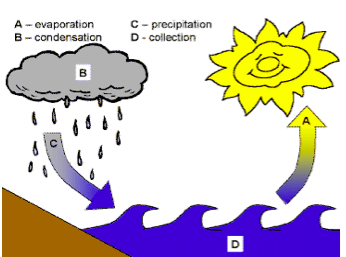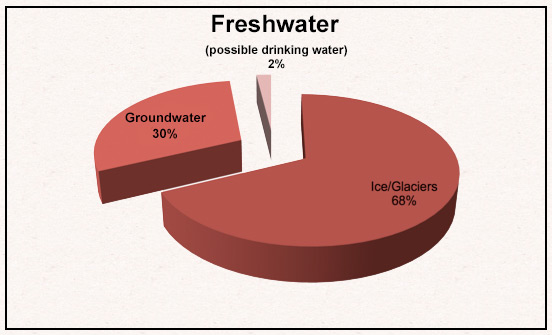Lesson 1: The Water Cycle
Jump To
- Objectives
- Background
- Materials
- Vocabulary
- Preparation
- Procedure
- Discussion
- Possible Questions
- Alternatives
Print this Page
Resources for This Lesson
Additional Resources
Objectives
- Students will learn about the water cycle and the importance of conserving and protecting the small amount of freshwater on Earth.
Background
The water cycle has no starting point. But, let’s begin with large bodies of water. The sun, which drives the water cycle, heats water. Some of it evaporates as vapor into the air. Evaporation rates go up as the temperature goes up. (In fact, the process of evaporation removes heat from the environment, which is why we sweat. Water evaporating from your skin cools you.) Rising air currents take the vapor up into the atmosphere, along with water evaporated from the soil and from evapotranspiration, which is water transpired from plants. The vapor rises into the air where cooler temperatures cause it to condense into clouds. Air currents move clouds around the globe; cloud particles collide, grow, and fall out of the sky as precipitation. Some precipitation falls as rain. Some falls as snow and can accumulate in ice caps and glaciers, which can store frozen water for thousands of years.
Look at the peaks of Mt. Kenya. The white you see is snow and glaciers. Snow packs in warmer climates often thaw and melt when spring arrives, and the melted water flows overland as snowmelt. Most precipitation falls into bodies of water or onto land, where, due to gravity, the precipitation flows over the ground. Some soaks back into the soil and is used by plants to survive and grow. Some, especially on bare ground, continues to flow as surface runoff.
A portion of runoff enters rivers in valleys, with stream flow moving water toward the larger bodies of water (even the oceans). Runoff, and groundwater seepage, accumulate and are stored as freshwater in lakes. Not all runoff flows into rivers, though. Much of it soaks into the ground. Some water infiltrates deep into the ground and replenishes aquifers (saturated subsurface rock), which store huge amounts of freshwater for long periods of time. Some infiltration stays close to the land surface and can seep back into surface-water bodies (and the ocean) as groundwater discharge, and some groundwater finds openings in the land surface and emerges as freshwater springs. It may sound as if all of the water is always moving. In fact, more water is “in storage” for long periods of time than is actually moving through the cycle.
Materials
- 4 bowls
- salt
- water
- plastic wrap
- something to stir with
- a larger bowl (that does not let light in) to cover one of the smaller ones
- notebooks
Vocabulary
- atmosphere: the gaseous envelope surrounding Earth; the air
- condensation: water vapor in the air gets cold and changes back into liquid, forming clouds
- evaporation: the process by which water changes from a liquid to a gas or vapor
- evapotranspiration: water transpired from plants and evaporated from the soil
- precipitation: rain, hail, sleet, or snow, all of which are formed by condensation of moisture in the atmosphere and fall to the ground when so much water has condensed that the air cannot hold it anymore
- snowmelt: water from melting snow
Preparation
Prepare a place (indoors or out) where the bowls can sit mainly in the sun for several days (if necessary).
Procedure
- Explain that the balance of water on Earth remains fairly constant over time. However, individual water molecules can come and go quickly. The water in the banana or cabbage leaf you ate yesterday may have fallen as rain halfway around the world last year or could have been drinking water for a dinosaur millions of years ago. So how does all of this water get reused over and over?
- Prepare the four bowls, pouring equal amounts of water into each bowl. Securely cover the first with plastic wrap, leave the second uncovered, dissolve salt into the third, and cover the fourth with the larger bowl.
- Ask the kids to hypothesize in their notebooks what will happen to equal amounts of water under the same conditions with these variables.
- Have students make observations through drawings or words.
- Have 10 students read the water cycle reader’s theater at the end of the lesson and on Worksheet 1: The Water Cycle.
- At the end of class check the bowls for changes. (The change may take up to several days.)
- Finish today’s lesson having the students draw the water cycle.

If necessary, check back on your bowls at a later time. Noticeable changes should include various rates of evaporation. Also, note the salt solution should have salt crystals remaining. Students should write their conclusions about any aspects of the water cycle in their notebooks.
Discussion
Of the world’s total water supply, over 96 percent is saline (salt) water, which is unfit for humans to drink. And, of the total freshwater, over 68 percent is locked up in ice and glaciers. Another 30 percent of freshwater is in the ground. Fresh surface-water sources, such as rivers and lakes, only constitute about 1/150th of one percent of total water. Yet, rivers and lakes are the sources of most of the water people use every day.


Possible Questions
- Why didn’t the salt crystals evaporate (too heavy)? What can you infer about saltwater during evaporation (salt stays behind)?
- Describe what happened when___________ .
- What would the result be if Earth’s freshwater were polluted?
- How would you change something people do to protect the water cycle?
- What is the most important part of the water cycle and why?
- What could you invent to be sure Earth always has enough safe water?
Alternatives
1. If you’re in need of faster results, put very cold water in a glass in the sun. Water forms on the outside of the glass from the air. Water vapor in the warm air turns back into liquid when it touches the cold glass (condensation).
2. Students could form groups and write their own script of the water cycle or tell their own story through the perspective of one of the components of the water cycle e.g.; the sun, water drop).
3. Have 10 students read the following script. Neither props nor scenery are necessary. (To print this script, click Worksheet 1 under Resources.)
Parts:
Narrator
Water
Vapor
Ocean Drop Friends 1, 2, 3, 4, 5
Ice Crystal
Water Drop
Sun
Narrator: Our story starts in a large body of water. We are watching a drop of water.
Water Drop: It’s getting hot in here. I don’t think I can swim any more. I’m feeling light and airy! Sun what are you doing to me?
Sun: I can’t help it. I’m hot and full of energy. That’s what I do, and I do it so well, don’t I?
Water Drop: Yes, you do, but I think I’m getting dizzy. I’m feeling so strange! I think I’ll just float for a while - no more swimming for me.
Sun: Uh oh! You’re not floating in the water anymore, you’re floating in the air - you’re not a drop of water either - you’re water vapor now.
Water Drop: What’s water vapor?
Sun: It’s water, but it’s a gas. You’ve evaporated and turned into a gas.
Narrator: The drop of water looks around and begins to feel lonely in the sky.
Water Drop: I feel like joining others and forming a crowd.
Sun: I think you mean a cloud, not a crowd.
Water Drop: Hey can I join you?
Water Vapor: Yes, my friends and I were just getting ready to play our favorite game. It’s called Condense.
Water Drop: Great, how do you play?
Water Vapor: Condensing means that we’ll change back into a liquid (water, of course). Then we’ll be part of a cloud.
Narrator: So the little drop of water joined his new friends for a game of Condense.
Water Vapor: Wow you’re good at this game. Now we’re a beautiful, fluffy cloud. Let’s fly over the land and watch the goats.
Water Drop: Wow, they seem so small from up here. Take a look at those beautiful mountains! Brrr, it’s getting cold. I’m feeling heavy.
Narrator: Now the little drop of water has turned into snow.
Water Drop: Hey, what’s got six arms and there’s nothing exactly like it in the whole world?
Water Vapor: Me - I’m so special. You, too, of course. We’re both snowflakes. Hey, where are you going now?
Water Drop: I can’t stop falling - you’re falling too. But where are we going?
Water Vapor: The only place we can fall, down.
Water Drop: Thanks - I knew that.
Narrator: As the snowflakes fell they landed on a glacier.
Water Drop: Well, it looks like we’ve landed on a river of ice.
Water Vapor: I’m getting crushed here. Now I’m ice - this is NOT my favorite part of the water cycle.
Ice Crystal: What are you complaining about? You just got here. We’ve been here for years and we only move at about one foot each year.
Water Drop and Water Vapor: This is going to be soooooo boring.
Ice Crystal: You’d better get used to it, we’re stuck on this glacier for a while.
Narrator: The sun, hearing their conversation, moves slightly toward the glacier to warm them up. A long, long, long time
later, two very bored drops of water emerge from the bottom of the glacier and join a cool mountain stream.
Water Drop: Wow, I’ve finally melted!
Water vapor: Me too - I’m free at last. We were practically standing still, and now we’re shooting the rapids! Watch out for that rock! And that waterfall!
Water Drop: Ouch! I’ve had enough of this. Can I go home now?
Water Vapor: We don’t have a home. At least we’re out of the mountains.
Water Drop: The water’s getting deeper. What’s going on here?
Water Vapor: You can slow down now - we’re in a river. And we’re getting warmer.
Water Drop: I like this. Not too fast and not too slow. But where are we headed now?
Water Vapor: Just go with the flow.
Narrator: After some time the drops reach a large lake.
Water Drop: We’re finally back.
Water Vapor: You know, I’ve done this trip a million times, and every time it’s different.
Ocean Drop Friend 1: Hey, look who’s back.
Water Drop: I had quite an amazing trip.
Ocean Drop Friend 2: I was well water in Washington once.
Ocean Drop Friend 3: I was in a typhoon in Thailand twice.
Ocean Drop Friend 4: I was rain in Rwanda.
Ocean Drop Friend 5: I was snow in Siberia.
Ocean Drop Friend 2: We’ve all been snow in Siberia. But I was in a puddle in Pakistan.
Ocean Drop Friend 5: I was in a lake in Louisiana.
Ocean Drop Friend 4: I was in a swamp in Switzerland.
Ocean Drop Friend 2: There are no swamps in Switzerland. But a long, long time ago, I was sleet that fell on the snout of a T. rex.
Ocean Drop Friend 3: Showoff! I rained on a plain in Spain. I seeped through the soil, and went into a cave, and was groundwater for 500 years.
Ocean Drop Friend 1: Boooorrrrrring.
Sun: Hi there! It’s me again.
Water Vapor: I feel so hot and dizzy!
Water Drop: Oh no, it’s starting all over again!
Ocean Drop Friend 3: I wonder where we’re going this time?
